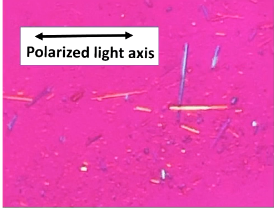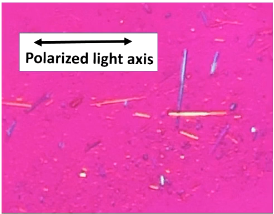Gait, Synovial Fluid Analysis, Ligament Structure, Function and Failure, Joint Damage Part 1
1/13
There's no tags or description
Looks like no tags are added yet.
Name | Mastery | Learn | Test | Matching | Spaced |
|---|
No study sessions yet.
14 Terms
Which type of crystal is typically found in gout?
Monosodium urate crystals
Which type of crystal is typically found in pseudogout?
Calcium pyrophosphate crystals

What is this
Positive birefringence

What is this
Negative Birefringence

What disease is this
Gout

What disease causes this
Pseudogout
What best describes a Grade 1 ligament sprain?
Mild stretching with microscopic tearing of fibers
Which of the following characterizes a Grade 2 ligament sprain?
Partial tear with some loss of function and moderate instability
How is a Grade 3 ligament sprain defined?
Complete tear resulting in joint instability and loss of function
Which of the following correctly lists components found in synovial fluid?
Hyaluronic acid, lubricin, water, proteinase, collagenase, prostaglandins
What best describes Grade 1 osteoarthritis?
Minor cartilage wear with possible osteophyte formation
Which describes Grade 2 osteoarthritis?
Moderate cartilage damage with definite joint space narrowing
What is characteristic of Grade 3 osteoarthritis?
Severe cartilage loss, joint space obliteration, and bone sclerosis
Which of the following best describes Grade 4 osteoarthritis?
Complete loss of cartilage with severe joint space narrowing and bone deformity